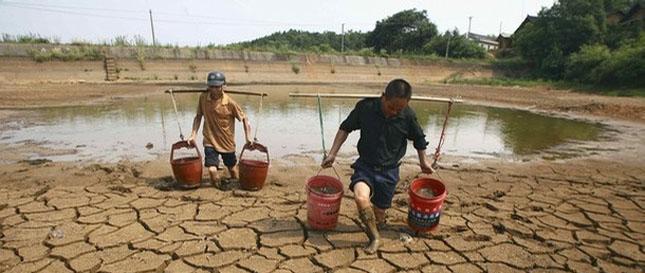Drying Up: China’s Looming Water Crises

By Joyce Roque
Aug. 15 – A month before the ongoing Beijing Olympics, environmental NGO, Greenpeace, released a statement warning that the event may only worsen the already dire water situation in north China.
Greenpeace estimates that the event will consume about 200-million cubic meters of water in a city that they say may soon run out it in the next five to ten years.
The Beijing Olympic Committee assured that the event will use water wisely; hot water will be solar treated and toilets flushed with reclaimed water. The event guarantees a steady water supply by diverting four reservoirs in Hebei province to Beijing. Earlier this year, Hebei province suffered from a winter drought that affected 250,000 people and 3.3 million hectares of crops.
The best way to describe China and its water situation is nothing short of a crisis. China only has 7 percent of the world’s water resources yet has 20 percent of its population. The reforms of the ‘70s gave rise to bad policies and poor government administration that gave precedence to economic development above all else, even at the cost of ruining the environment.
In the country’s desire to attract foreign investment, lax environmental regulations have been tolerated and some polluting factories even protected by the local government. Producing goods in China wastes around 3 to 10 times more water compared to industries in developed nations.
The water situation is also aggravated by the government’s decision to make the country grain sufficient thus encouraging swaths of land to be converted for farming.Wheat production done mostly in the country’s North Plain is consuming huge amounts of underground water.
The statistics paint a grim picture: more than half of the country’s 660 cities have water shortages, Beijing being one of those cities, 90 percent of the cities’ groundwater and 75 percent of its rivers and lakes are polluted.
Out of the country’s seven main rivers, five of them tested positive for pollutants. An estimated 190 million Chinese people or 15 percent of the population are drinking contaminated water while a total of 300 million rural residents have no access to safe drinking water
Chinese experts predict that by 2030 per capita water resources could drop to an alarming 1760 cubic meters. The internationally recognized benchmark for water shortages is already 1700 cubic meters.
The government is aware of the water crisis but it remains to be seen how serious they are in implementing real environmental reforms and if the reforms can still reverse the damage.
Legislature recently revised the water pollution law that metes out tougher punishment for companies found guilty. One of the provisions calls for erring companies to pay 30 percent of direct losses incurred from serious water pollution incident and 20 percent for incidents of medium consequences.
The law now also allows environmental protection departments and relevant social organizations to support water pollution victims in lawsuits and the government encourages law firms and lawyers to provide legal aid to the victims. In the past, companies found polluting the environment were only given administrative penalties.
The State Environmental Protection Administration has approved three programs for the research and development of technologies needed to solve water pollution beginning 2008 to 2020 at an investment of billions of yuan.
More than an environmental problem, the water issue poses political and economic risks. There have been reports of protests in rural areas where water pollution from industries has affected livelihood and health. If left to fester for too long, the situation can only breed social unrest. And while the Beijing government wants to prioritize the environment, local authorities in cities may not share the same sentiments and focus on economic growth instead.
- Previous Article Asia’s Regional Economics: A Bowl of Rice a Day
- Next Article China Capital Investment Rises by 27%



























